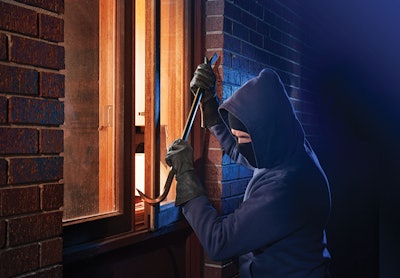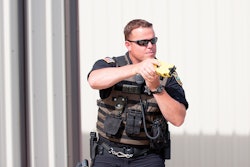My friend Jeff Barnes spent the bulk of his career in criminal investigations. He told me that he used investigating burglaries as his template for training new detectives. He felt that everything needed to solve and prosecute a burglary case could be applied to any investigation. Since Jeff's clearance rate was always above the national average, I'd say his training model has merit. With that in mind, let's take a look at some points to remember.
 First, you need to establish if you're investigating a burglary (or other crime) in progress, or if the incident has ended. (Photo: StockPhoto.com)
First, you need to establish if you're investigating a burglary (or other crime) in progress, or if the incident has ended. (Photo: StockPhoto.com)
In Progress Vs. Over-With
As with any call for service, there is a big difference between an in-progress call and one that is over with. The biggest concerns for an in-progress call revolve around victim and officer safety, securing the crime scene, and obviously doing everything possible to catch the suspect.
You have to document everything that leads up to the start of your investigation. How you received the call and what happens prior to the dust settling can make or break your investigation. One of your first goals is to establish the true nature of the call. If you find out it's no longer a felony in progress, then you can downgrade or cancel other responding units. If you confirm it's still a go, then you must document all the tactics you use in trying to capture the suspect, such as forming a perimeter and deploying K-9 teams.
There are a host of other considerations that include things like addressing any victim injuries, clearing the structure to make sure the suspect is not hiding inside, and finding any witnesses including any surveillance video. In other words, you must document everything involved.
If the call is over with, your sense of urgency is somewhat scaled down. The emergency factor is taken away and you can get right to the investigation part. But you still have to document who reported the call and the circumstances behind it. Someone coming home from a two-week vacation and finding out their front door was kicked in has a different set of details than a pawn shop that had its alarm cut off and rear wall breached. An investigation is all about the details.
Securing the Scene
Securing the scene is one of the most important considerations you have; it's where the bulk of your evidence lies. A mistake here can cost you the case. Not too long ago, I was made aware of an agency that mishandled a gun during a homicide investigation. After having his day in court, the suspect walked. That scenario could have easily been avoided if all those that were involved had understood that every part of an investigation is important. The whole is greater than the sum of its parts.
Securing the scene sets you up for things like processing the scene, interviewing witnesses, and keeping contamination out, including people. If you can't avoid unwanted guests, make sure you document who goes in and out by keeping a crime scene log. You'd be surprised at the number of rank and file I have kept out of my scenes by doing so. Gawkers know that being placed on that list puts them in line for a possible subpoena and a court appearance later on.
The level of training, equipment carried, and time required to process a scene should help determine who gets to do the honors. Any officer can accomplish a great deal with a basic finger print kit and a digital camera. However, there is a point at which it's better to call your crime scene technician to take over and let the officer go back to handling calls.
Speaking With Victims/Witnesses
After the scene is secured, you need to identify all your witnesses. If possible, keep witnesses from talking to each other, as this is not a group project. Once you get them talking, follow up their oral statements by taking a written sworn statement from each. You want them telling their story in their own words. You must also stress that the statement must be legible. It doesn't do anyone any good if it can't be read.
Be careful not to coach them through their statement, as this could come back to bite you in court. Instead of coaching, limit your involvement to bringing to their attention any information that was left out from their original oral statement or to any specific information required by your agency. For example, some agencies use a checkmark format for demonstrating a victim's desire to prosecute while others require that victims write this in their statement.
Also, remember to check for any electronic witnesses. In today's world of smartphones, surveillance cameras, and live network security feeds, there is bound to be something you can use, even if just to provide a time frame for the crime.
You need to document an area canvass as well. For example, a good rule of thumb for a residential burglary is to check with the neighbors in front, in back, and to the sides of the victim's home. Interview the residents for anything that might help. A dog barking at 03:00 may signify the suspect leaving the scene.
Gathering Evidence
Gathering evidence is another critical point. It's not just what you see but what you might find that helps the most. Look at the scene from the suspects' point of view. What did they have to do to commit the crime? Then work from there. For example, many officers often miss fingerprints from a hotel burglary. They forget to dust at the window next to the door. It's been my experience that suspects usually place their hands there while trying to see out the window before they leave. Another thing officers sometimes forget is to check around the perimeter of the crime scene. Suspects have been known to drop things or place objects in dumpsters. You never know what you will find until you look.
Writing a Thorough Report
Every police academy recruit learns how to write a report. They learn about the journalistic approach of answering who, what, when, where, why, and how. They learn to write not only what they do but why they don't do something as well (IE: the vehicle wasn't processed because of rain). They also learn that where their report stops, someone else's starts.
The problem we encounter is a disconnect between what you learn at the academy, what your field training officers show you, and what your first line supervisor accepts. If a conversation ever starts with "That was the academy and this is the real world," you know your report writing standards are about to go south. My recommendation is don't ignore what you learned at the academy and write a thorough report anyway. I also suggest you spend some time with your detectives working a case. Learn from them what they need and what they are looking for from your initial investigation.
Final Words
The principles involved in investigating a burglary are the same ones involved in investigating anything from a retail theft to a homicide. Nailing down how to handle burglaries will help you with all of your investigations.
Amaury Murgado retired a senior lieutenant from the Osceola County (FL) Sheriff's Office with over 29 years of experience. He also retired from the Army Reserve as a master sergeant. He holds a Master of Political Science degree from the University of Central Florida.















